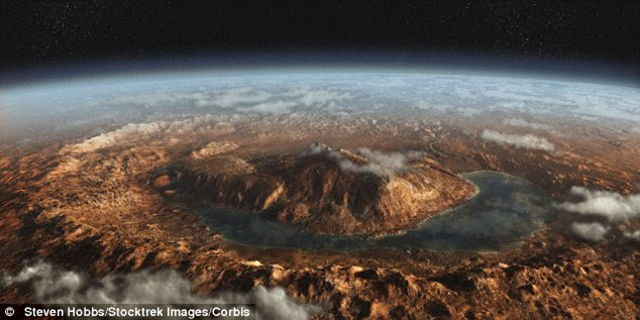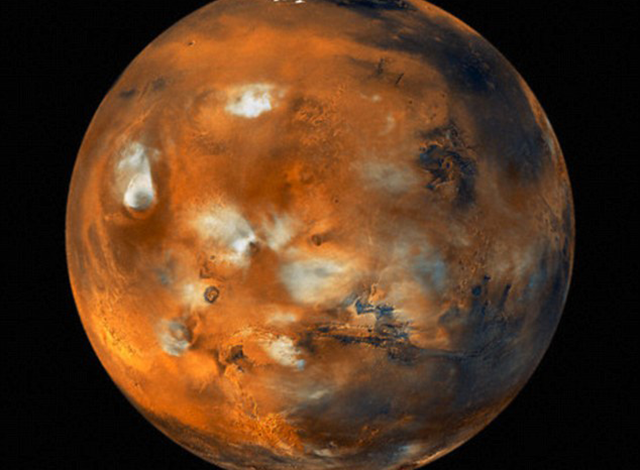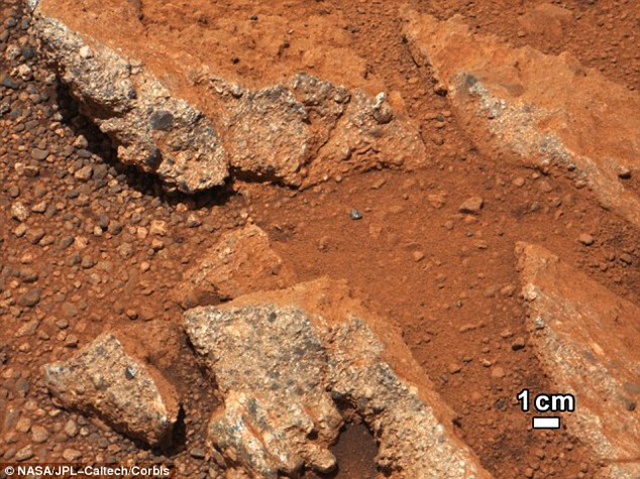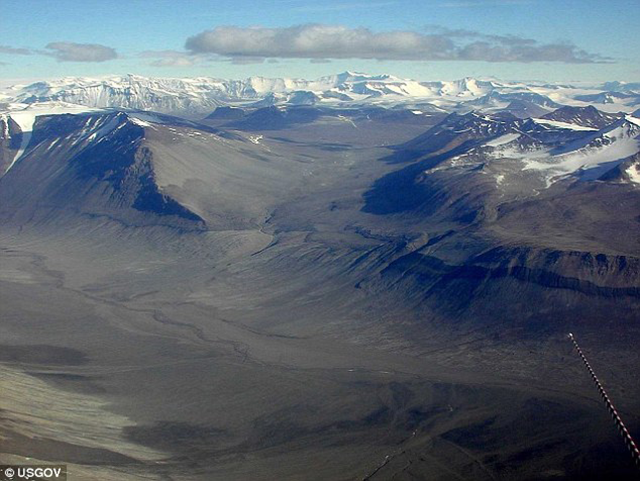- Scientists from Brown University and Israel's Weizmann Institute have claimed water on Mars could only survive briefly
- They claim it was only able to last for periods of tens or hundreds of years
- This was due to the temperature on Mars, which made water flow episodic
- Volcanoes spewed sulphur into the atmosphere and changed the climate
- When it warmed, it melted ices and snows, forming lakes and rivers
- But the climate would soon cool again, turning the liquid into ice
- This process may have occurred repeatedly in many episodes
- Evidence for water on Mars has been found in the form of dried up lakes, rivers and streams by the Curiosity rover
- But this is the first study to suggest water was episodic, not permanent

Research suggests that warmth and water flow on ancient Mars (illustration shown) were probably episodic. These temperature changes may have also been related to brief periods of volcanic activity that spewed tons of greenhouse-inducing sulphur dioxide gas into the atmosphere
Evidence of rivers, streams, and lakes suggests that Mars was, at some point, warm enough for liquid water to flow on its surface, according to a new study.
But, rather than having permanent bodies of water, as seen on Earth, the surface of Mars likely went through episodic periods.
The study suggests that periods of temperatures warm enough for water to flow may have only lasted for tens or hundreds of years at a time.
The study was carried out by scientists from Brown University and Israel's Weizmann Institute of Science.
Evidence of Water on Mars
Evidence of water on Mars dates back to the Mariner 9 mission, which arrived in 1971. It revealed clues of water erosion in river beds and canyons as well as weather fronts and fogs.
Viking orbiters that followed caused a revolution in our ideas about water on Mars by showing how floods broke through dams and carved deep valleys.
Mars is currently in the middle of an ice age, so liquid water cannot exist on its surface at the present time. However, the planet seems to have been warmer and wetter in the past.
In June last year, Curiosity found powerful evidence that water good enough to drink once flowed on Mars. In September, the first scoop of soil analysed by Curiosity revealed that fine materials on the surface of the planet contain two per cent water by weight.
These temperature changes may have also been related to brief periods of volcanic activity that spewed tons of greenhouse-inducing sulphur dioxide gas into the atmosphere.
The work combines the effect of volcanism with the latest climate models of early Mars.
With all that's been learned about Mars in recent years, the mystery of the planet's ancient water has deepened.
The latest generation of climate models for early Mars suggests an atmosphere too thin to heat the planet enough for water to flow.
The sun was also much dimmer billions of years ago than it is today, further complicating the issue.
However, when volcanoes spewed out gas the atmosphere may have warmed enough for liquid water to form periodically on the surface.
Co-author Dr James Head, Professor of Earth, Environmental and Planetary Sciences at Brown University, said: 'These new climate models that predict a cold and ice-covered world have been difficult to reconcile with the abundant evidence that water flowed across the surface to form streams and lakes.
'This new analysis provides a mechanism for episodic periods of heating and melting of snow and ice that could have each lasted decades to centuries.'

The work combines the effect of volcanism with the latest climate models of early Mars (mosaic shown). With all that's been learned about Mars in recent years, the mystery of the planet's ancient water has deepened. The researchers explored the idea that heating may have been linked to periodic volcanism

In this image from NASA's Curiosity rover in September 2012, a rock outcrop called Link pops out from a Martian surface that is elsewhere blanketed by reddish-brown dust. The fractured Link outcrop has blocks of exposed, clean surfaces that are consistent with deposits of water on Earth
The researchers explored the idea that heating may have been linked to periodic volcanism.
Many of the geological features that suggest water flow date to around 3.7 billion years ago, a time when massive volcanoes are thought to have been active and huge lava outpourings occurred.
However, on Earth widespread volcanism often leads to cooling rather than warming.
Sulphuric acid particles and thick ash reflect the sun's rays, and that can lower temperatures.
But the researchers thought the effects of sulphur on Mars's dusty atmosphere might have been different.
To find out, they created a model of how sulphuric acid might react with the widespread dust in the Martian atmosphere.
The work suggests that those sulphuric acid particles would have stuck onto dust particles, which would reduce their ability to reflect the sun's rays.
Meanwhile sulphur dioxide gas would produce a modest greenhouse effect - just enough to warm the Martian equatorial region so that water could flow.
Dr Head has been doing fieldwork for years in Antarctica and thinks the climate on early Mars may have been very similar to that of the cold, desert-like McMurdo Dry Valleys.

Professor Head has been doing fieldwork for years in Antarctica and thinks the climate on early Mars may have been very similar to that of the cold, desert-like McMurdo Dry Valleys (pictured) in Antarctica
He said: 'The average yearly temperature in the Antarctic Dry Valleys is way below freezing, but peak summer daytime temperatures can exceed the melting point of water, forming transient streams, which then refreeze.
'In a similar manner, we find that volcanism can bring the temperature on early Mars above the melting point for decades to centuries, causing episodic periods of stream and lake formation.'
But as that early active volcanism on Mars ceased, so did the possibility of warmer temperatures and flowing water.
Dr Head said the research may offer new clues about where the fossilised remnants of life might be found on Mars, if it ever existed, and added: 'Life in Antarctica, in the form of algal mats, is very resistant to extremely cold and dry conditions and simply waits for the episodic infusion of water to "bloom" and develop.
'Thus, the ancient and currently dry and barren river and lake floors on Mars may harbour the remnants of similar primitive life, if it ever occurred on Mars.'
